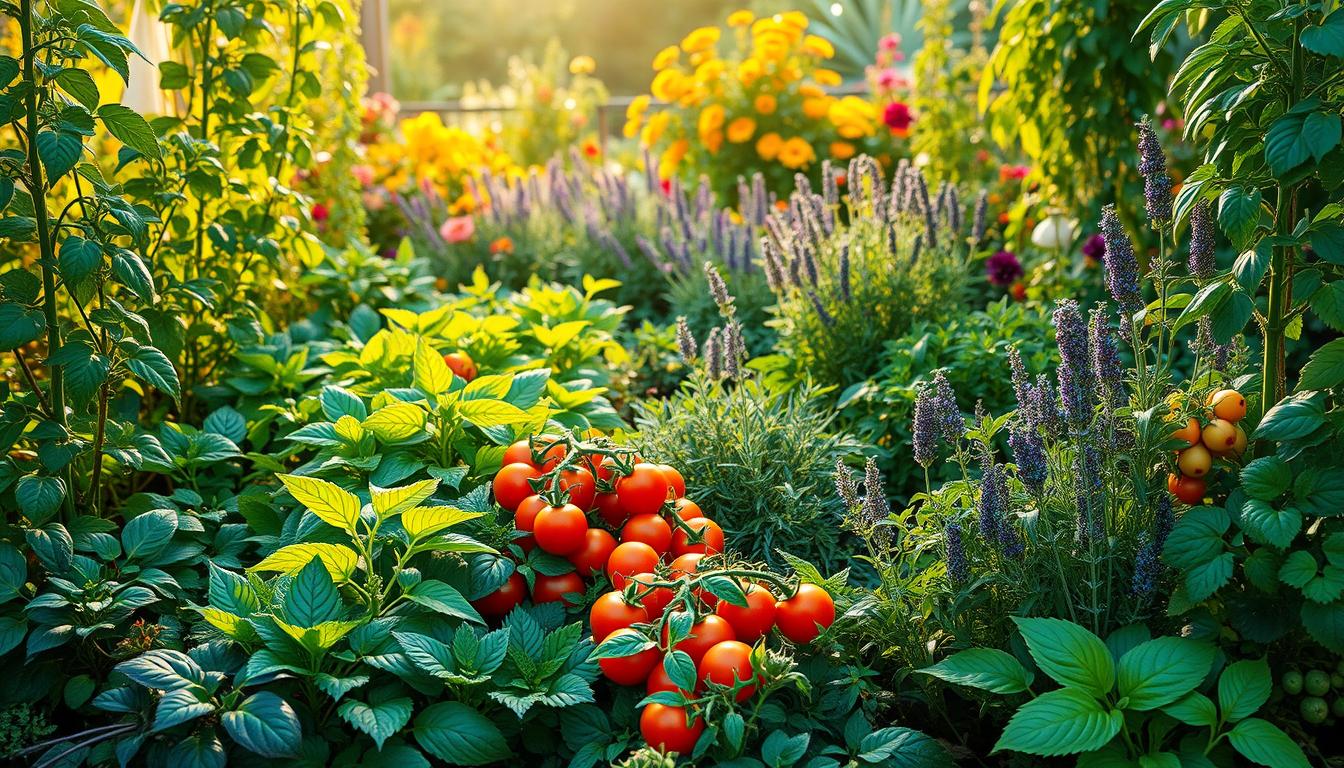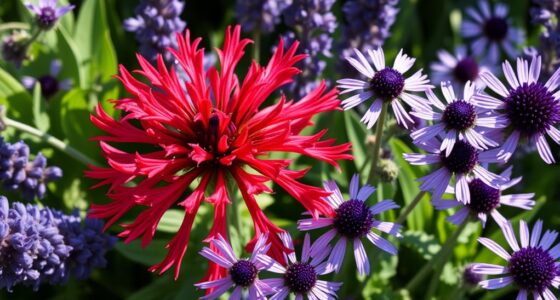Have you ever stared at your garden, wondering how to transform it into a lush, thriving oasis? You’re not alone. Many gardeners yearn for that breathtaking space, a healthy garden that truly reflects their passion for nature. The secret lies not just in the right soil or sunlight, but in the art of companion planting. This age-old technique pairs plants together to boost their growth and productivity naturally. Imagine being able to maximize your garden’s potential by simply selecting companions that support and enhance each other. In this article, you will discover how to create a vibrant garden ecosystem through effective companion planting, ensuring that your efforts yield not just bountiful harvests, but also a serene escape in which to unwind and connect with nature.
Key Takeaways
- Companion planting is essential for maximizing your garden’s potential.
- Choosing the right plant companions enhances growth and pest resistance.
- A healthy garden benefits from strategic plant pairings.
- Implementing companion planting techniques can lead to higher crop yields.
- This method fosters a more resilient and vibrant ecosystem.
What is Companion Planting?
Understanding the definition of companion planting provides insight into one of the most effective gardening strategies available. This practice involves growing different plants together to mutually benefit their growth and health. The importance of companion planting lies in its ability to build a resilient garden ecosystem where plants collaborate, enhancing each other’s health and productivity.
Definition and Importance
The definition of companion planting encompasses various methods where specific plant pairings serve distinct purposes. By attracting beneficial insects, providing essential nutrients, or even warding off pests, the right combinations can significantly improve the effectiveness of your gardening efforts. The importance of companion planting cannot be overstated, as it fosters a healthier environment and promotes sustainable gardening practices.
Benefits for Your Garden
The benefits of companion planting include a host of advantages that positively impact your garden’s overall health. Not only does it help in reducing pest infestations, but it also enhances soil fertility by facilitating nutrient exchange between plants. A diverse plant layout creates a more visually appealing garden while enabling you to grow a wider variety of crops. By incorporating companion planting techniques, you cultivate a balanced atmosphere that maximizes your garden’s potential.

| Benefit | Description |
|---|---|
| Reduced Pest Infestations | Companion plants can repel harmful pests, leading to fewer diseases. |
| Improved Soil Fertility | Certain plants enrich the soil, promoting healthier growth for all nearby plants. |
| Visual Appeal | Diverse combinations create a more attractive garden space. |
Key Principles of Companion Planting
Understanding the core aspects of companion planting principles plays a crucial role in developing a thriving garden. You have the opportunity to create beneficial plant relationships that foster growth and health among your crops. Recognizing the distinction between companion plants and competitive plants in gardening is vital; while some plants complement each other, others may compete for nutrients and space, hindering overall development.
Companion vs. Competitive Plants
In gardening, it is essential to distinguish between plants that enhance each other’s growth and those that create obstacles. Companion plants can share nutrients, deter pests, and improve soil structure. On the other hand, competitive plants may struggle for the same resources, leading to stunted growth. Identifying these dynamics can greatly influence your planting strategy.
Understanding Plant Relationships
Various plant relationships significantly impact your garden’s health and productivity. For example, certain plants can fix nitrogen in the soil, enriching it for their neighbors. Others may provide shade, protecting more delicate plants from harsh sunlight. Building a successful garden relies on the careful selection and arrangement of plants to maximize these interactions.
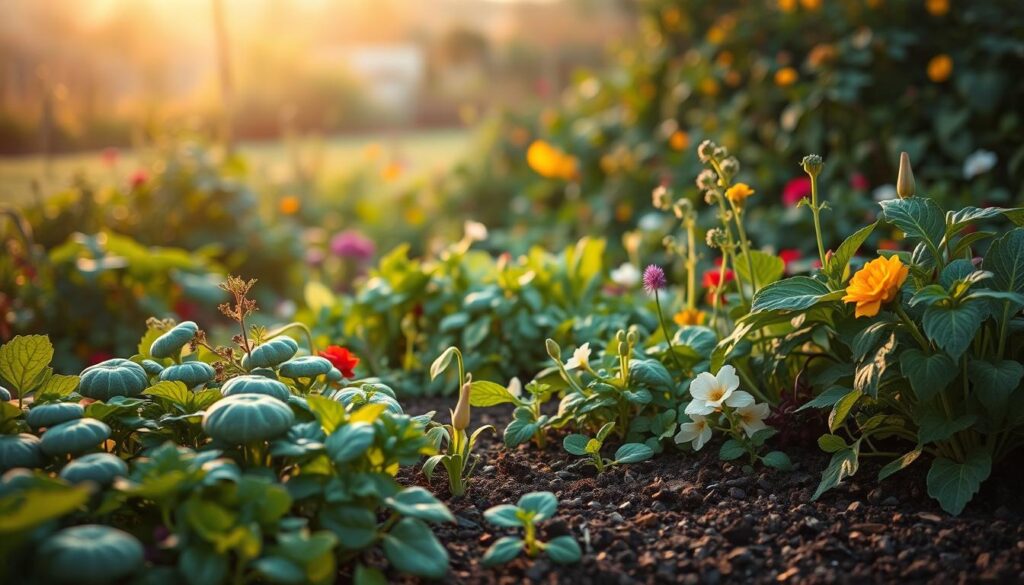
Popular Companion Planting Combinations
Exploring popular companion plant combinations can significantly enhance the growth and health of your garden. Certain plant pairings have demonstrated remarkable benefits, creating a harmonious environment where each plant complements the other. Let’s delve into some well-known combinations that showcase the effectiveness of companion planting.
Tomatoes and Basil
One of the most celebrated partnerships is between tomatoes and basil. Not only does basil enhance the flavor of tomatoes, but it also helps repel pests such as thrips. Growing these two together can lead to a thriving garden where both plants flourish.
Carrots and Onions
The combination of carrots and onions proves to be another effective strategy in companion planting. Onions produce a strong scent that naturally deters several pests that target carrots. By planting these two together, your garden can enjoy a healthier crop with reduced pest interference.
Beans and Corn
A classic example of companion planting is the Three Sisters method, incorporating beans, corn, and squash. In this trio, corn serves as a natural support for climbing beans, while beans contribute nitrogen back into the soil, benefiting all three plants. This synergy showcases how beans and corn can create a sustainable growing environment.

| Combination | Benefits |
|---|---|
| Tomatoes and Basil | Enhances flavor, repels pests |
| Carrots and Onions | Strong scent deters pests |
| Beans and Corn | Nitrogen fixation, structural support |
Benefits of Companion Planting
Companion planting can transform your gardening experience with its numerous benefits. By understanding how specific plants work together, you can achieve optimal results in your garden. Let’s explore how this organic technique contributes to natural pest control, enhanced nutrient uptake, and improved crop yields.
Natural Pest Control
One of the most celebrated benefits of companion planting is its ability to provide natural pest control. Certain plants can effectively repel unwanted insects or attract beneficial predators that manage pest populations. For instance, marigolds are often planted with vegetables to keep harmful nematodes away, resulting in a healthier garden ecosystem.
Enhanced Nutrient Uptake
Another significant advantage is the enhanced nutrient uptake achieved through the combination of various plants. When deep-rooted and shallow-rooted species share space, they can access different layers of soil simultaneously. This synergy allows for better utilization of soil nutrients, promoting growth and vigor among all plant partners.
Improved Crop Yields
As a result of natural pest control and enhanced nutrient uptake, you can expect increased crop yields from your garden. Healthier plants that thrive with fewer pests and adequate nutrients become more resilient to environmental stressors. This leads to not just a higher quantity of produce, but often improved quality as well.

Plants to Avoid in Companion Planting
Understanding which plants to avoid is essential for successful companion planting. Some plants naturally hinder each other’s growth, leading to incompatible plant pairings that can stunt development and reduce yields. Recognizing these combinations helps you maintain a healthy garden environment.
Incompatible Pairings
Certain plants simply do not get along. For example, garlic is known to stunt the growth of peas, creating an unfavorable condition for both plants. Similarly, planting cabbage alongside strawberries can lead to reduced yields for both. It’s vital to be aware of these incompatible pairings to ensure your garden flourishes.
Toxic Combinations
Some plants release substances into the soil that inhibit the growth of nearby plants. A prime example of this is the black walnut tree. The toxins it generates can harm many vegetables, herbs, and flowers. Identifying and avoiding toxic plant combinations will help preserve your garden’s overall health and productivity.
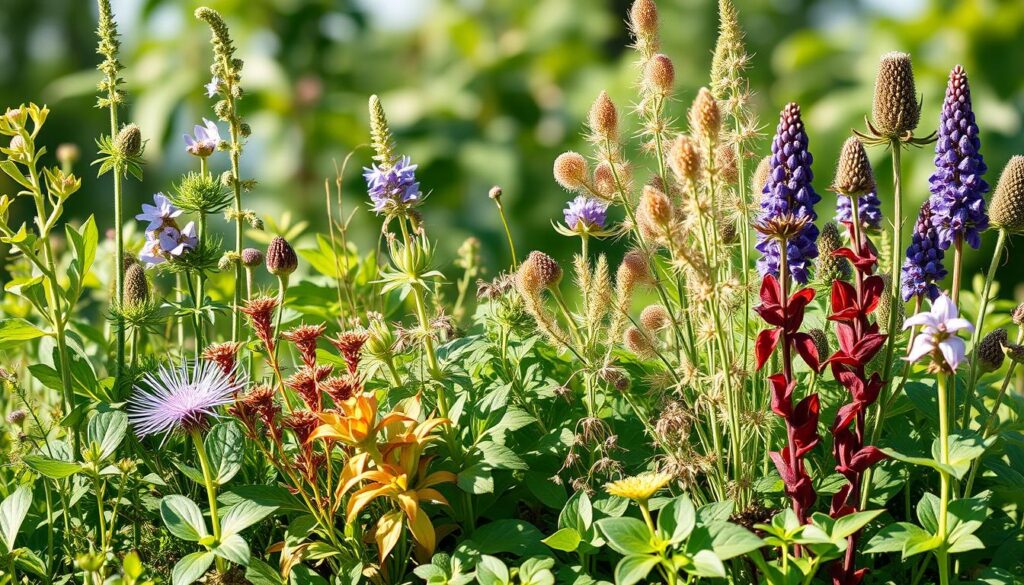
How to Plan Your Garden Layout
Effective garden layout planning plays a crucial role in the success of companion planting. When you start mapping plant combinations, it’s essential to consider the unique needs of each plant in order to create an environment that promotes growth and health. An organized layout can lead to fruitful outcomes while minimizing competition among plants.
Mapping Your Plant Combinations
Begin your garden layout by strategically mapping your plant combinations. Identify which plants complement each other and will thrive together in the same space. For example, certain herbs can deter pests that affect vegetables, making them ideal companions. Use a grid or plan outline to visualize placement and ensure that you are maximizing available space while keeping plants at their optimal distances.
Factors to Consider in Layout Design
Several layout design factors must be taken into account to ensure a successful garden. These include:
- Sunlight requirements: Different plants have varying needs for sunlight. Position sun-loving plants in well-lit areas while placing shade-tolerant ones in less sunny spots.
- Spacing: Adequate spacing helps prevent overcrowding. Each plant has specific spacing needs to ensure air circulation and nutrient accessibility.
- Plant height: Arrange taller plants in a way that they do not shade smaller plants that require more sunlight. Vertical gardening options can also help maximize this aspect.

Seasonal Considerations for Planting
Timing plays a vital role in the success of your companion planting efforts. Understanding the growing seasons of different plants can significantly influence the health and yield of your garden. Applying some seasonal planting tips will help you choose the best planting time for companion plants, ensuring that they support each other’s growth. Additionally, implementing seasonal crop rotation can prevent soil depletion and pest issues, keeping your garden thriving throughout the year.
Best Time to Plant Companions
The key to successful companion planting lies in knowing the optimal time for each crop. Certain plants have specific temperature and light requirements that dictate their growth cycle. For warm-season plants like tomatoes and peppers, aim to plant after the last frost. In contrast, cool-season crops like spinach and broccoli can be planted earlier in the spring or even in late summer for a fall harvest. Matching the timing of planting with the natural growing season will optimize the benefits of companion planting.
Seasonal Rotation Techniques
Seasonal crop rotation involves switching out different plant families in specific areas of your garden each season. This practice fosters soil vitality and disrupts pest and disease cycles. Incorporating legumes in your rotation can enhance soil nitrogen levels, benefiting subsequent crops. For example, follow peas with heavy-feeders like corn or tomatoes. Rotate crops annually to prevent nutrient exhaustion and maintain balanced soil health.

Companion Planting for Pest Management
Incorporating companion planting into your gardening routine offers a natural method for effective pest management. This strategy not only deters pests but also promotes a balanced ecosystem. Utilizing plants like marigolds can significantly enhance your garden’s ability to repel unwanted invaders.
Using Marigolds for Nematodes
Marigolds for nematodes provide a fantastic solution for gardeners facing soil-borne pests. These vibrant flowers release compounds that deter nematodes when planted alongside affected crops. Their roots emit natural substances that disrupt the life cycle of these pests, reducing their population effectively without the use of harsh chemicals.
Attracting Beneficial Insects
Attracting beneficial insects is another cornerstone of companion planting pest management. By planting specific flowers, you can invite insects such as ladybugs, lacewings, and hoverflies into your garden. These creatures prey on harmful pests, helping to keep your garden healthy and thriving. Creating a habitat for these beneficial insects encourages a sustainable gardening environment.
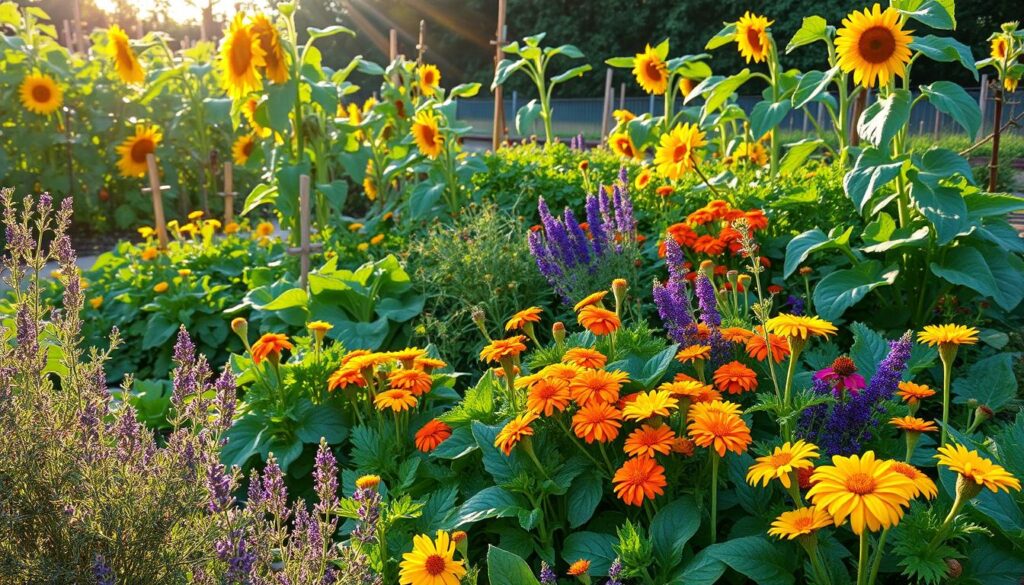
| Beneficial Insects | Pests They Control | Preferred Companion Plants |
|---|---|---|
| Ladybugs | Aphids, scale | Dill, fennel, marigolds |
| Lacewings | Aphids, caterpillars, mealybugs | Chervil, coriander, yarrow |
| Hoverflies | Aphids, thrips | Flowers like cosmos, daisies, and sweet alyssum |
Implementing these companion planting practices not only enhances your garden’s vitality but also contributes to long-term pest management solutions. Embracing these natural methods ensures that your garden remains productive while maintaining a healthy ecosystem.
Enhancing Soil Health with Companion Plants
Companion planting serves as a powerful tool for enhancing soil health in your garden. By strategically combining different plants, you can promote nitrogen fixation and improve soil structure, creating a thriving ecosystem for your crops.
Nitrogen Fixation
Certain plants, particularly legumes, are natural champions of nitrogen fixation. These plants harbor bacteria in their root nodules that transform atmospheric nitrogen into a form usable by plants. When you include legumes in your garden, you not only benefit from their yields but also enrich the soil with essential nutrients beneficial for other surrounding plants.
Soil Structure Improvements
Deep-rooted plants, such as radishes and alfalfa, contribute significantly to improving soil structure. Their roots penetrate the soil, creating channels that allow water and air to flow more freely. This not only increases the soil’s aeration but also enhances its ability to retain moisture, providing a better environment for all your garden plants and further enhancing soil health.
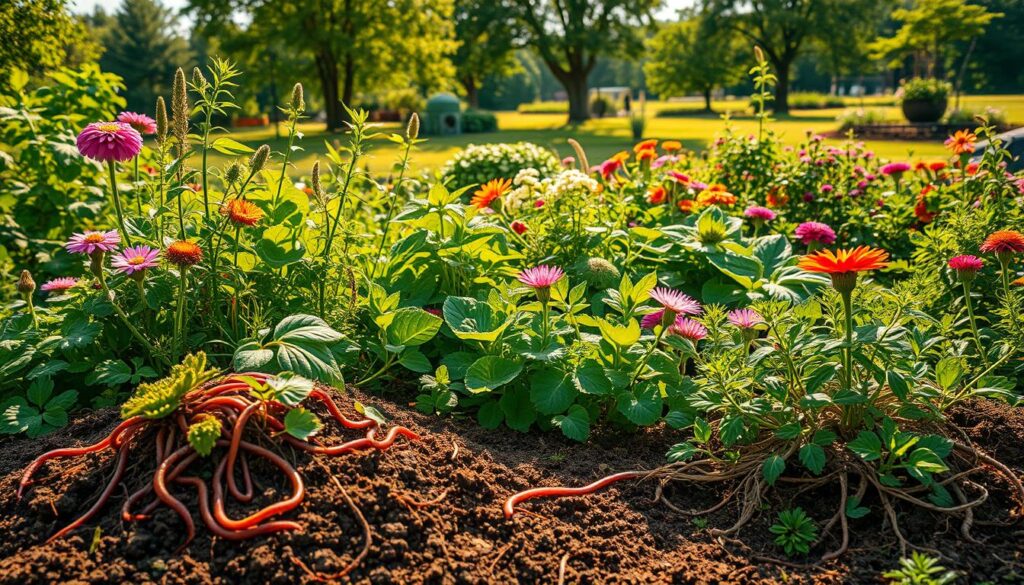
Companion Planting for Pollinator Attraction
Attracting pollinators to your garden can significantly enhance the health and yield of your plants. Implementing companion planting techniques is a great way to create a space that encourages bees, butterflies, and other beneficial insects. By carefully selecting the best flowers for pollinators, you can ensure a thriving and vibrant pollinator-friendly garden.
Best Flowers for Pollinators
Choosing the right flowers is crucial for maximizing the presence of pollinators in your garden. Some of the best flowers for pollinators include:
- Borage: Known for its star-shaped flowers, borage attracts a variety of bees.
- Calendula: This cheerful flower provides nectar for numerous pollinating insects.
- Zinnias: Bright and colorful, zinnias are a magnet for butterflies and bees alike.
Creating a Pollinator-Friendly Garden
To make your garden truly inviting for pollinators, consider the following tips:
- Plant in clusters to create a more visible color and scent presence.
- Incorporate a variety of blooming plants to provide continuous nectar sources throughout the season.
- Avoid pesticides and herbicides that can harm pollinator populations.

The Role of Companion Planting in Sustainable Gardening
Companion planting significantly contributes to sustainable gardening practices. By incorporating this method into your garden, you engage in strategies that enhance the natural balance of your ecosystem. This approach emphasizes natural pest management and supports plant health, fostering an environment where diverse species can thrive together.
Reducing Chemical Usage
One major benefit of companion planting involves reducing chemical usage. With the right plant combinations, you can deter pests naturally and minimize the need for synthetic pesticides. Plants like marigolds and herbs serve as natural repellents, creating a healthier growing environment for your crops without relying on harsh chemicals.
Promoting Biodiversity
Companion planting plays a crucial role in promoting biodiversity. When you plant different species together, you attract various beneficial insects, like pollinators and predators of harmful pests. This diverse ecosystem supports a resilient garden, encouraging natural interactions among plants and wildlife. By fostering such diversity, your garden becomes not only more productive but also an essential part of the local environment.

Case Studies of Successful Companion Planting
Exploring successful companion planting case studies enables you to gather practical insights and inspiration for your gardening journey. You may find that real-life gardening examples offer compelling evidence of how effective these techniques can be when implemented thoughtfully. From community gardens to individual plots, many have harnessed the power of companion planting to cultivate thriving ecosystems.
Real-Life Examples
A prime example of successful companion planting is the “Three Sisters” method. This technique involves planting corn, beans, and squash together, benefiting each other in various ways. Corn provides a sturdy structure for beans to climb, beans fix nitrogen in the soil, and squash’s broad leaves shade the ground, reducing weeds and retaining moisture. Many gardeners have witnessed impressive yields and reduced pest issues by utilizing this method.
Lessons Learned from Gardeners
Lessons learned in gardening often come from challenges faced along the way. For instance, some gardeners discovered that incorporating flowers with their vegetables attracted beneficial insects while repelling harmful pests. This approach led to healthier plants and improved harvests. Engaging with fellow gardeners and sharing experiences enhances your understanding, allowing you to adapt and refine your companion planting strategies effectively.

Tools and Resources for Companion Planting
When embarking on your companion planting journey, having the right tools and resources can make all the difference. Whether you are an experienced gardener or just starting, understanding which gardening books and guides to consult can enhance your knowledge. Various online gardening resources and apps offer valuable insights into successful plant pairings, allowing you to make informed choices.
Gardening Books and Guides
Choosing the right gardening books can provide a wealth of information on companion planting. These texts often cover essential strategies, compatibility of plants, and tips for successful gardening. Some popular gardening books include:
- The Vegetable Gardener’s Guide to Permaculture – This book details sustainable practices that benefit plant relationships.
- Companion Planting for Beginners – A straightforward guide focusing on easy-to-follow plant pairings.
- Garden Alchemy: 50 Super-Secret Solutions – Offers creative solutions for enhancing plant growth and health.
Online Resources and Apps
In addition to printed materials, you can access numerous online gardening resources designed to assist you. Apps such as “From Seed to Spoon” and “Garden Planner” provide interactive platforms for planning your garden layout. You can find articles, charts, and tools focused on companion planting tools. These resources help you visualize your garden and track your progress.
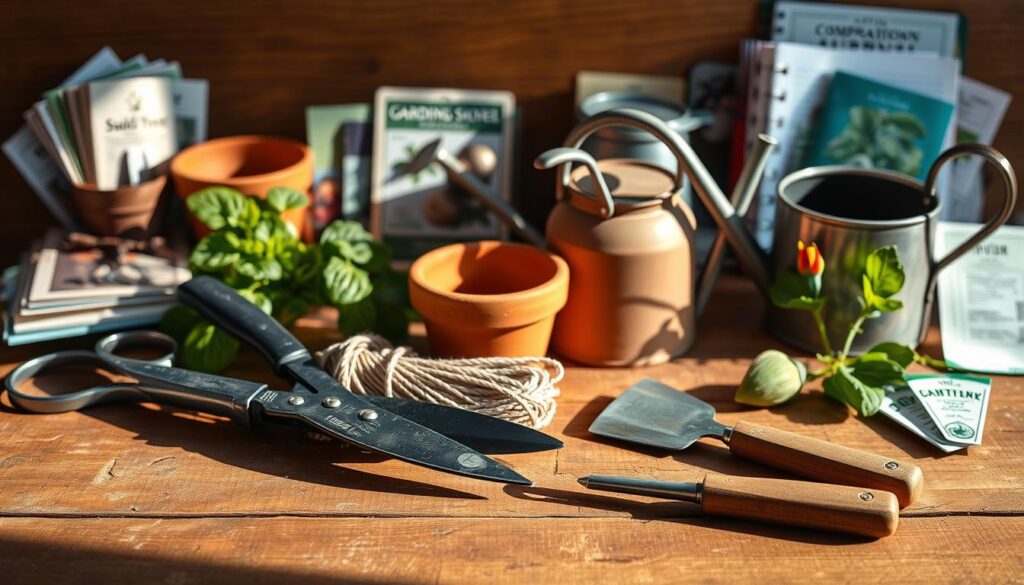
Troubleshooting Companion Planting Issues
Even experienced gardeners face challenges when engaging in troubleshooting companion planting. Identifying common gardening problems allows you to better manage your garden. This knowledge is crucial, as it helps you understand how to adjust your approach to maximize garden success.
Common Problems You Might Encounter
While companion planting can lead to impressive results, it may not always go as planned. Some typical challenges include:
- Unexpected pest outbreaks that can damage your plants.
- Poor growth or yield from specific plant pairings.
- Incompatibility between chosen companion plants, leading to stunted development.
Solutions and Best Practices
Addressing these issues involves implementing effective solutions for gardening issues:
- Adjust spacing to ensure plants have adequate room to grow.
- Change companion selections based on compatibility studies.
- Implement pest management strategies, like introducing beneficial insects that can help control pests without harming your garden.
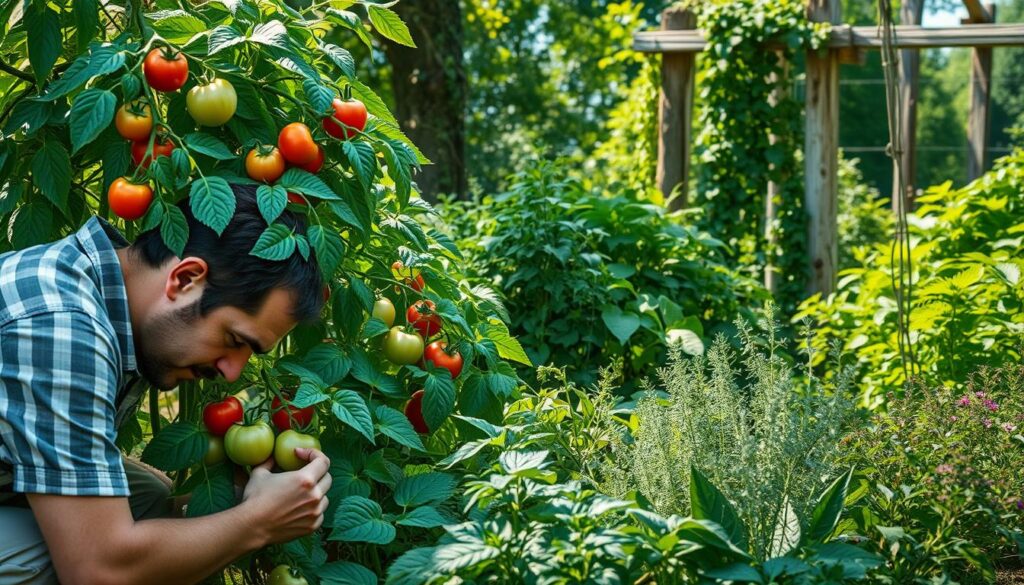
Future Trends in Companion Planting
As gardening practices evolve, the future trends in companion planting highlight the importance of adaptability and ingenuity in urban settings. With a growing emphasis on sustainability, you may find these innovative practices enhancing your gardening experience and yielding impressive results.
Innovations in Gardening Techniques
Exciting gardening innovations such as vertical gardening and hydroponic systems show how traditional approaches are being reimagined. These methods not only save space but also help maximize resource usage. For gardeners in limited areas, these advancements enable the practice of companion planting in unexpected ways. You can combine the benefits of different plants with unique growing styles, creating a flourishing environment even in the smallest spaces.
The Movement Towards Urban Companion Planting
The movement towards urban gardening practices is reshaping how we approach companion planting. Many city dwellers are increasingly seeking out sustainable solutions to bring greenery into their lives. This trend fosters resilience in urban environments, allowing you to grow fresh produce amidst the concrete jungle. By implementing companion planting techniques in urban gardens, you can cultivate healthier plants while helping to create a greener planet.
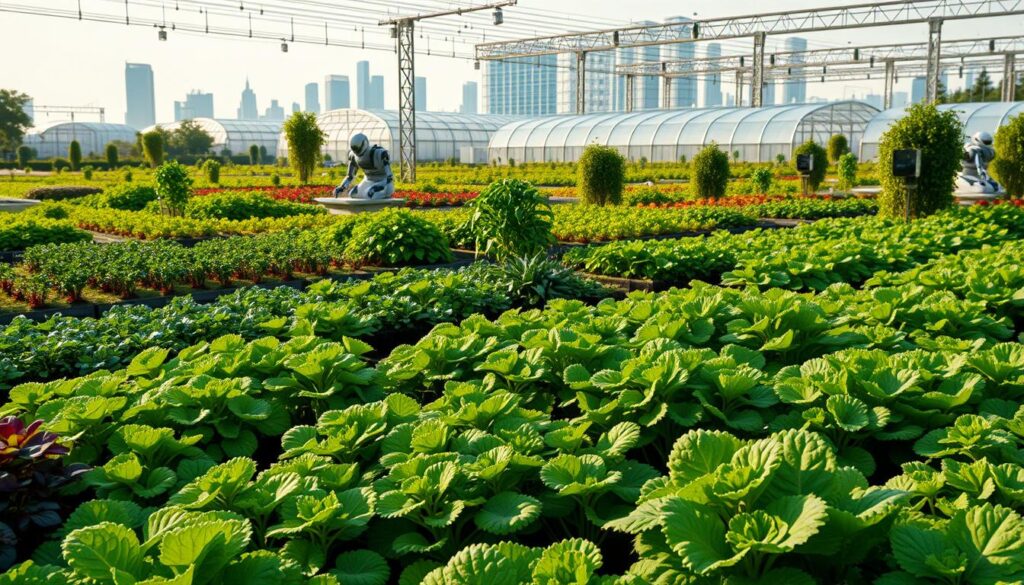
Getting Started with Your Companion Planting Journey
Venturing into the realm of companion planting can be an exhilarating experience for every garden enthusiast. For those eager to start companion planting, the first step is to select a few popular plant combinations, such as tomatoes and basil, which have proven to thrive together. Research their specific care requirements to ensure you are adequately prepared for their needs. Mapping out your garden layout while keeping these pairings in mind will set a solid foundation for your gardening endeavors.
As you begin your journey, be open to experimentation. Don’t hesitate to mix and match different companions to observe how they interact. One of the best beginner gardening tips is to keep a journal of your findings; this can help track what works best and what doesn’t. By remaining curious and patient, you will likely discover the combinations that yield the greatest success in gardening.
To achieve a thriving companion planting garden, leverage available resources, including books and community gardening groups. These platforms can provide valuable insights and advice from seasoned gardeners. Remember, each trial is a learning opportunity, and with consistent effort, you will cultivate a garden that flourishes harmoniously.
